Multi-Fracture Growth Law for Temporary Plugging and Diversion Fracturing of Horizontal Well with Multiple Clusters in Shale Reservoir
Abstract
:1. Introduction
2. Methodology
2.1. Analysis of Reservoir Mineral Composition and Rock Mechanical Properties
2.1.1. Mineral Composition Testing
2.1.2. Triaxial Compression Testing
2.2. Experimental Method
2.2.1. Experimental Apparatus
2.2.2. Preparation of Fracturing Samples
2.3. Experimental Parameters
3. Results and Discussion
3.1. Overall Geometric Morphology of HFs
3.2. Dynamic Expansion Process of Multi-Fractures
3.3. Analysis of Factors Affecting HF Formation during TPDF
3.3.1. Influence of Cluster Number
3.3.2. Influence of Perforating Method
4. Conclusions
Author Contributions
Funding
Data Availability Statement
Conflicts of Interest
Abbreviations
| α, β | empirical parameters in the similarity equation |
| QM, QF | pumping rate under laboratory and field conditions, m3/min |
| wM, wF | fracture width under laboratory and field conditions, mm |
| hM, hF | fracture height under laboratory and field conditions, m |
| SM, SF | inter-cluster spacing under laboratory and field conditions, m |
| LM, LF | half-length of the fracture under laboratory and field conditions, m |
| TPDF | temporary plugging and diversion fracturing |
| IFTP | inner-fracture temporary plugging |
| ISTP | inner-segment temporary plugging |
| HF | hydraulic fracture |
| THF | transverse hydraulic fracture |
| BP | bedding plane |
| XRD | X-ray diffraction |
| CT | computed cosmography |
References
- Zhang, L.; Zhou, F.; Mou, J.; Pournik, M.; Tao, S.; Wang, D.; Wang, Y. Large-scale true tri-axial fracturing experimental investigation on diversion behavior of fiber using 3D printing model of rock formation. J. Pet. Sci. Eng. 2019, 181, 106171. [Google Scholar] [CrossRef]
- Wang, B. Investigation of Fracture Plugging and Diverting Patterns in Temporary Plugging and Diverting Fracturing; China University of Petroleum: Beijing, China, 2019. [Google Scholar]
- Li, M.; Zhou, F.; Sun, Z.; Dong, E.; Zhuang, X.; Yuan, L.; Wang, B. Experimental study on plugging performance and diverted fracture geometry dur-ing different temporary plugging and diverting fracturing in Jimusar shale. J. Pet. Sci. Eng. 2022, 215, 110580. [Google Scholar] [CrossRef]
- Li, Y.; Zhang, Q.; Zou, Y. Experimental Investigation of the Growth Law of Multi-Fracture during Temporary Plugging Fracturing within a Stage of Multi-Cluster in a Horizontal Well. Processes 2022, 10, 637. [Google Scholar] [CrossRef]
- Wang, M.; Wang, J.; Cheng, F.; Chen, X.; Yang, X.; Lv, W.; Wang, B. Diverter plugging pattern at the fracture mouth during temporary plugging and diverting fracturing: An experimental study. Energy Rep. 2022, 8, 3549–3558. [Google Scholar] [CrossRef]
- Wang, D.B.; Zhou, F.J.; Ge, H.K. Experimental study on the fiber-based diverting fracturing technology of artifi-cial fractures and its field application. Chin. J. Northeast. Pet. Univ. 2016, 40, 80–88+6. [Google Scholar]
- Wang, D.B. Diverting Mechanism and Its Law of Temporary Plugging in Hydraulic Fracturing; China University of Petroleum: Beijing, China, 2017. [Google Scholar]
- Li, W.; Ji, Z.S. Finite element analysis of temporary plugging and fracturing mechanism. Chin. J. Fault-Block Oil Gas Field 2016, 23, 514–517. [Google Scholar]
- Yuan, L.; Zhou, F.; Li, B.; Gao, J.; Yang, X.; Cheng, J.; Wang, J. Experimental study on the effect of fracture surface morphology on plugging effi-ciency during temporary plugging and diverting fracturing. J. Nat. Gas Sci. Eng. 2020, 81, 103459. [Google Scholar] [CrossRef]
- Wang, T.; Chen, M.; Wu, J.; Lu, J.; Luo, C.; Chang, Z. Making complex fractures by re-fracturing with different plugging types in large stress difference reservoirs. J. Pet. Sci. Eng. 2021, 201, 108413. [Google Scholar] [CrossRef]
- Hu, D.F.; Ren, L.; Li, Z.X. Simulation of fracture control during fracture-opening temporary plugging fracturing of deep/ultra deep shale-gas horizontal wells. Chin. J. Nat. Gas Ind. 2022, 42, 50–58. [Google Scholar]
- Zhang, R.; Hou, B.; Tan, P.; Muhadasi, Y.; Fu, W.; Dong, X.; Chen, M. Hydraulic fracture propagation behavior and diversion characteristic in shale for-mation by temporary plugging fracturing. J. Pet. Sci. Eng. 2020, 190, 107063. [Google Scholar] [CrossRef]
- Shi, S.; Cheng, F.; Wang, M.; Wang, J.; Lv, W.; Wang, B. Hydrofracture plugging mechanisms and evaluation methods during tempo-rary plugging and diverting fracturing. Energy Sci. Eng. 2022, 10, 790–799. [Google Scholar] [CrossRef]
- Bing, H.O.; Muhadasi, Y.; Weineng, F.; Peng, T. Experimental Study on the Hydraulic Fracture Propagation for Shale Temporary Plugging and Diverting Fracturing. Chin. J. Liaoning Petrochem. Univ. 2020, 40, 98–104. [Google Scholar]
- Wang, B.; Zhou, F.; Yang, C.; Wang, D.; Yang, K.; Liang, T. Experimental Study on Injection Pressure Response and Fracture Geometry during Temporary Plugging and Diverting Fracturing. SPE J. 2020, 25, 573–586. [Google Scholar] [CrossRef]
- Li, J.; Zou, Y.; Shi, S.; Zhang, S.; Wang, J.; Ma, X.; Zhang, X. Experimental Study on Fracture Propagation Mechanism of Shale Oil Reservoir of Lucaogou Formation in Jimusar. Geofluids 2022, 2022, 6598575. [Google Scholar] [CrossRef]
- Zhang, Z.; Zhang, S.; Zou, Y.; Ma, X.; Li, N.; Liu, L. Experimental investigation into simultaneous and sequential propagation of multiple closely spaced fractures in a horizontal well. J. Pet. Sci. Eng. 2021, 202, 108531. [Google Scholar] [CrossRef]
- Yushi, Z.; Shicheng, Z.; Tong, Z.; Xiang, Z.; Tiankui, G. Experimental investigation into hydraulic fracture network propagation in gas shales using CT scanning technology. Rock Mech. Rock Eng. 2016, 49, 33–45. [Google Scholar] [CrossRef]
- Li, N.; Zhang, S.C.; Ma, X.F.; Zou, Y.S.; Chen, M.; Li, S.H.; Zhang, Y.N. Experimental study on the propagation mechanism of hydraulic fracture in glutenite formations. Chin. J. Rock Mech. Eng. 2017, 36, 2383–2392. [Google Scholar]
- Li, N.; Zhang, S.C.; Zou, Y.S. Experimental analysis of hydraulic fracture growth and acoustic emission response in a layered formation. Rock Mech. Rock Eng. 2018, 51, 1047–1062. [Google Scholar] [CrossRef]
- Liu, G.H.; Pang, F.; Chen, Z.X. Similarity criterion in hydraulic fracturing simulation experiments. Chin. J. Univ. Pet. 2000, 5, 45–48. [Google Scholar]
- Naizhen, L.I.; Zhang, Z.; Yushi, Z.O.; Xinfang, M.A.; Zhang, Y. Propagation law of hydraulic fractures during multi-staged horizontal well frac-turing in a tight reservoir. Pet. Explor. Dev. 2018, 45, 1059–1068. [Google Scholar]
- Chen, J.; Wang, Y.; Zhao, X.; Tang, C.; Gao, Y.; Zhou, D.; Zeng, B.; Liu, X.; Li, W.; Wu, J.; et al. Chemical Agents Diversion with Microseismic Monitoring—New Prospects of Refracturing for Open-Hole Horizontal Well in Tight Oil Reservoir of Junggar Basin, China; OnePetro: Richardson, TX, USA, 2020. [Google Scholar] [CrossRef]
- Wu, Z.; Zou, H.; Wang, Y.; Wu, L.; Li, Y.; Xu, Y.; Wang, R.; Meng, Q.; Jiang, W.; Wang, S.; et al. Research and Application of Retreatment Technology to Tap Remaining Oil in Chang Qing Low Permeability Oilfield. In Proceedings of the International Petroleum Technology Conference, Beijing, China, 26–28 March 2020. [Google Scholar]
- Wang, Y.; Zhao, X.; Shang, J.; Tang, C.; Deng, J.; Xing, Y. Novel Technology to Improve Recovery of Remaining Oil in Tight Glutenite Reservoir of Junggar Basin: Employing Chemical Diverting Agents in Refracturing Operation. In Proceedings of the Abu Dhabi International Petroleum Exhibition & Conference, Abu Dhabi, United Arab Emirates, 9 November 2020. [Google Scholar]
- Zhang, L.F.; Zhou, F.J.; Feng, W.; Cheng, J. Temporary Plugging Mechanism of Degradable Diversion Agents within Re-produced Acid-Etched Fracture by Using 3D Printing Model. In Proceedings of the Abu Dhabi International Petroleum Exhibition & Conference, Abu Dhabi, United Arab Emirates, 9 November 2020. [Google Scholar]
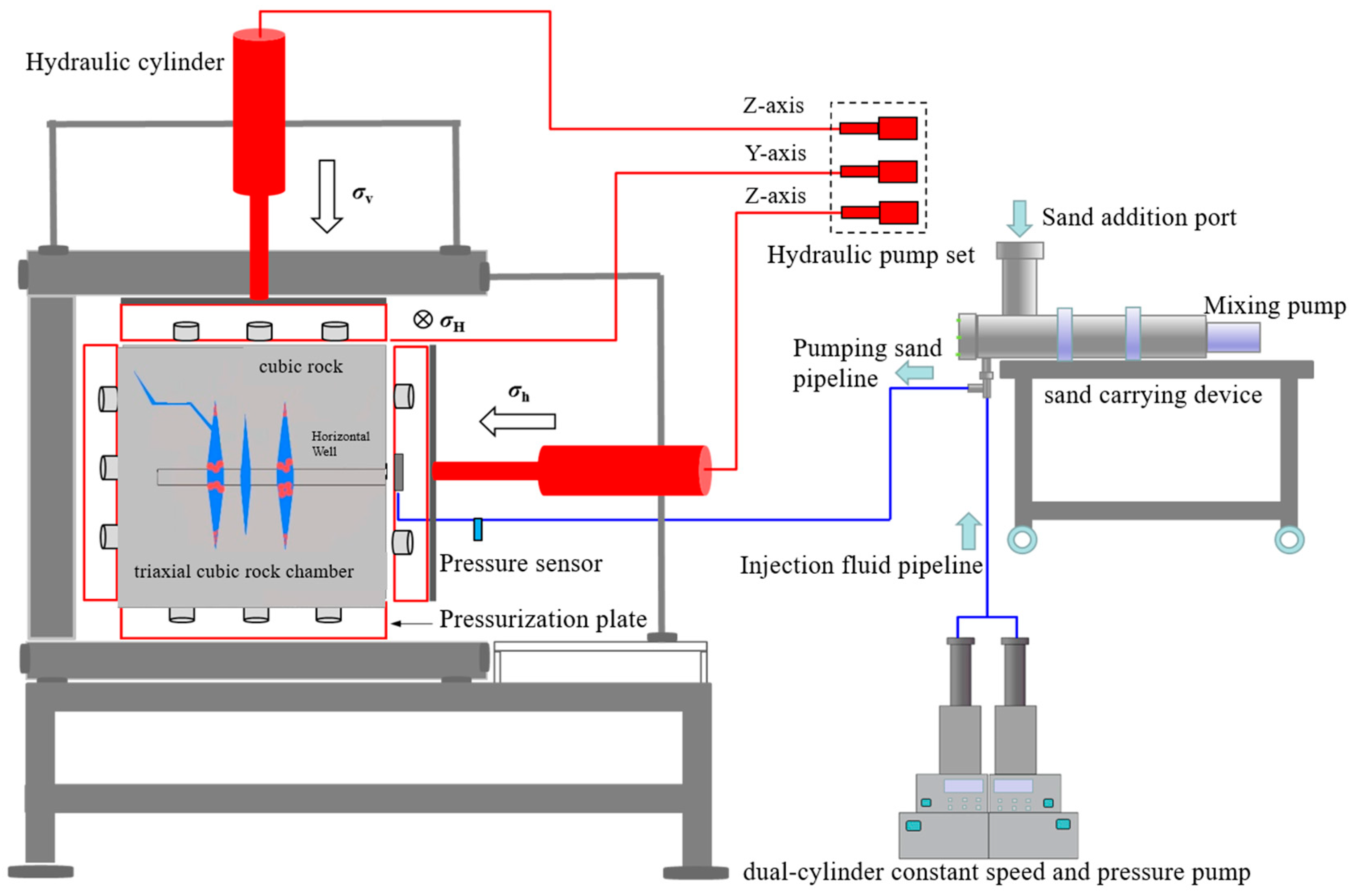



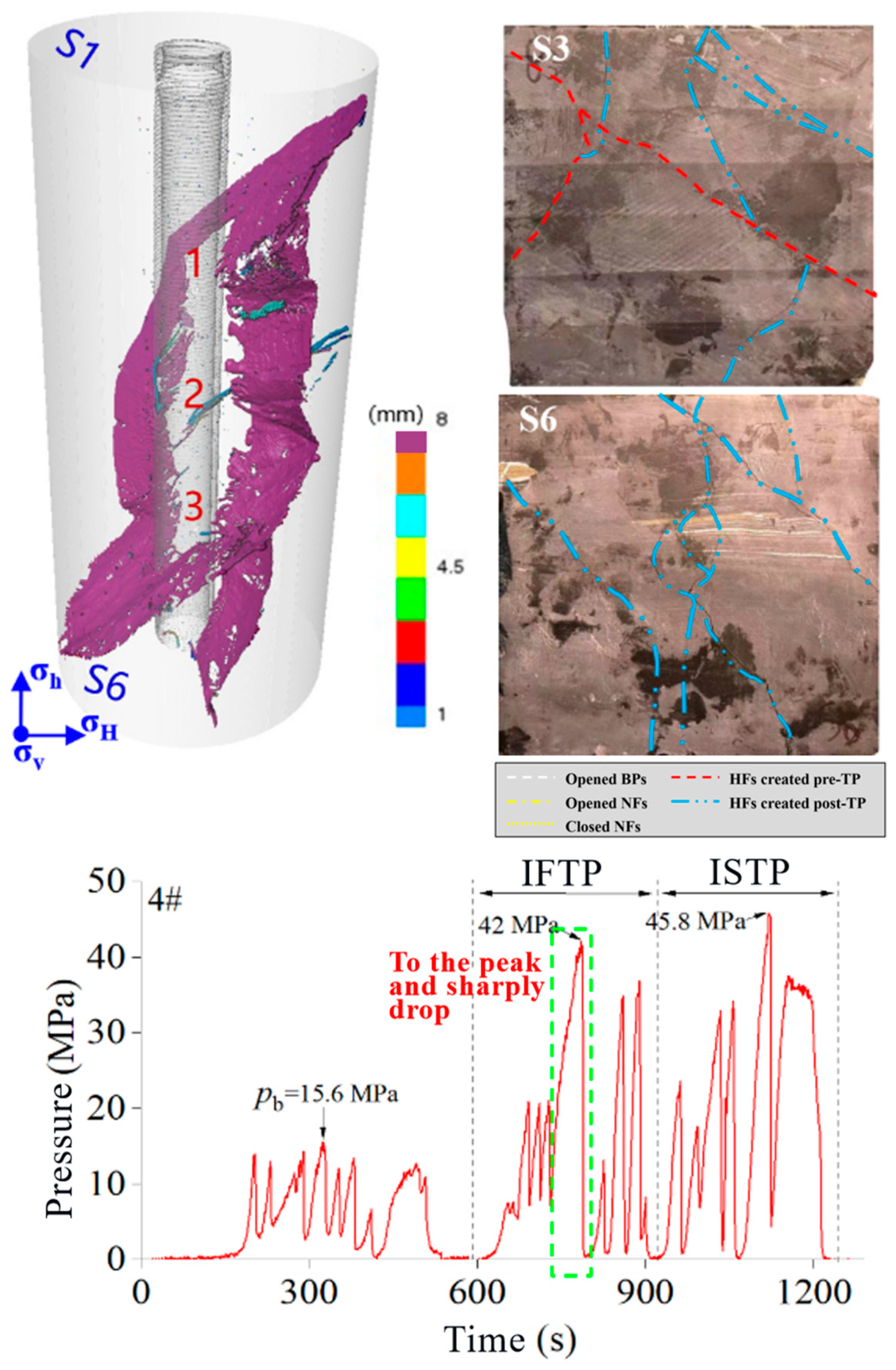

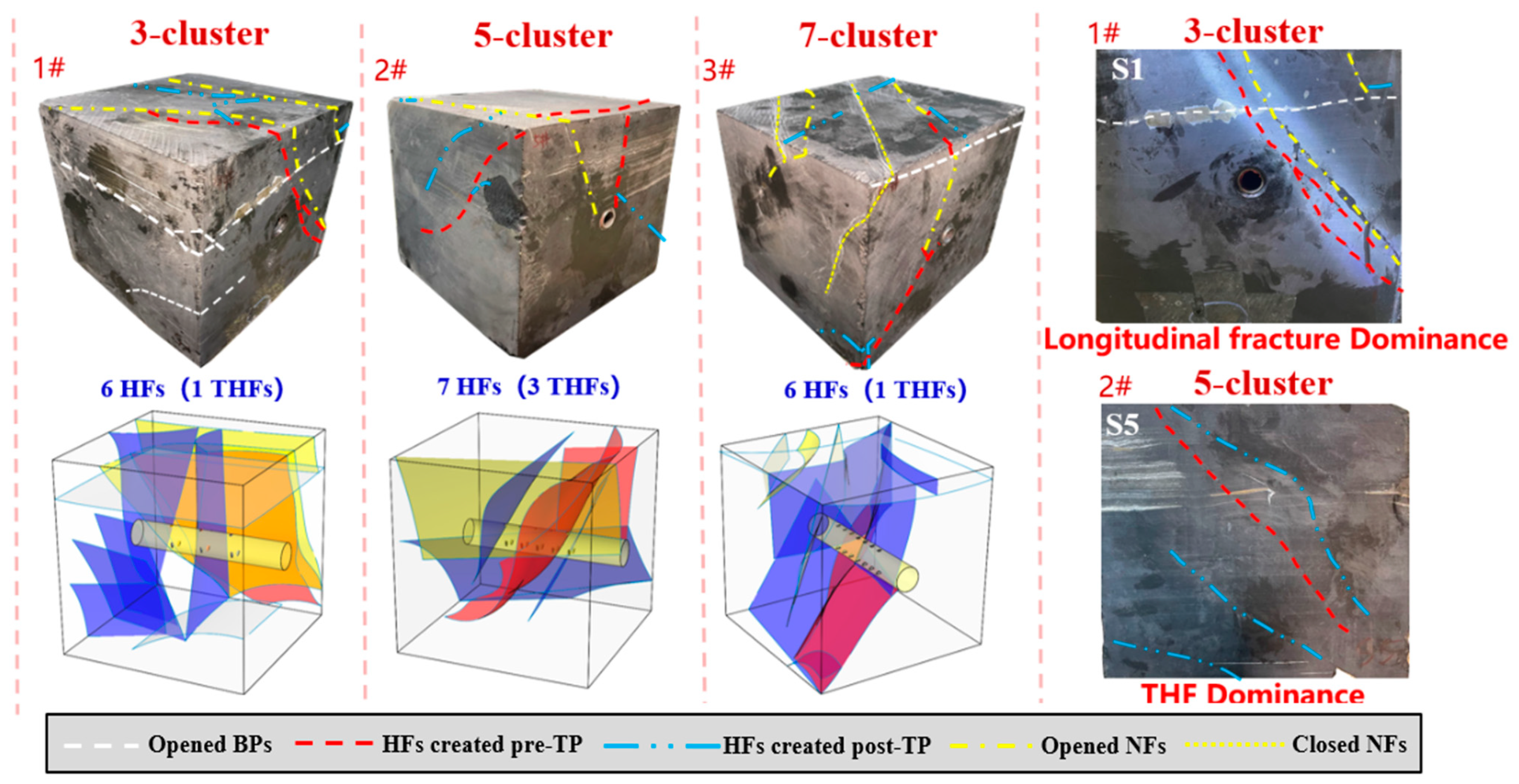
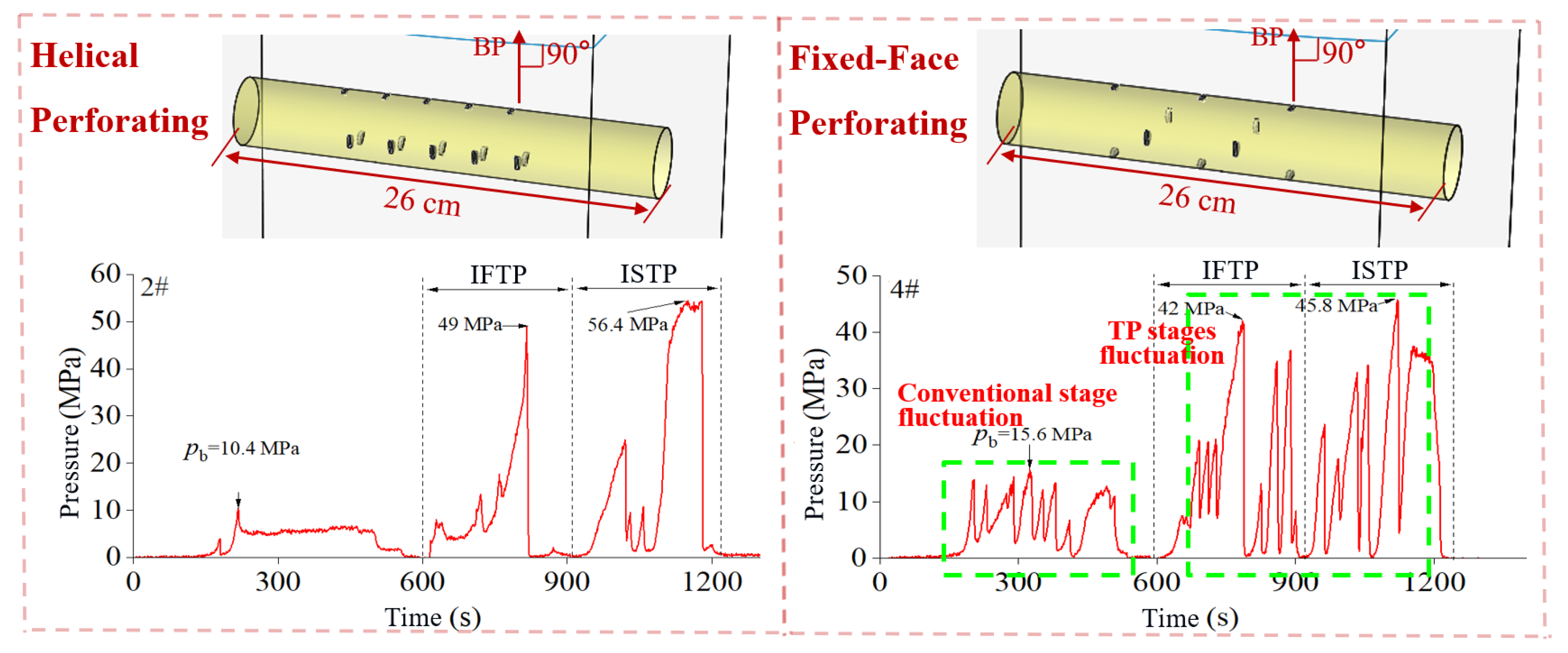
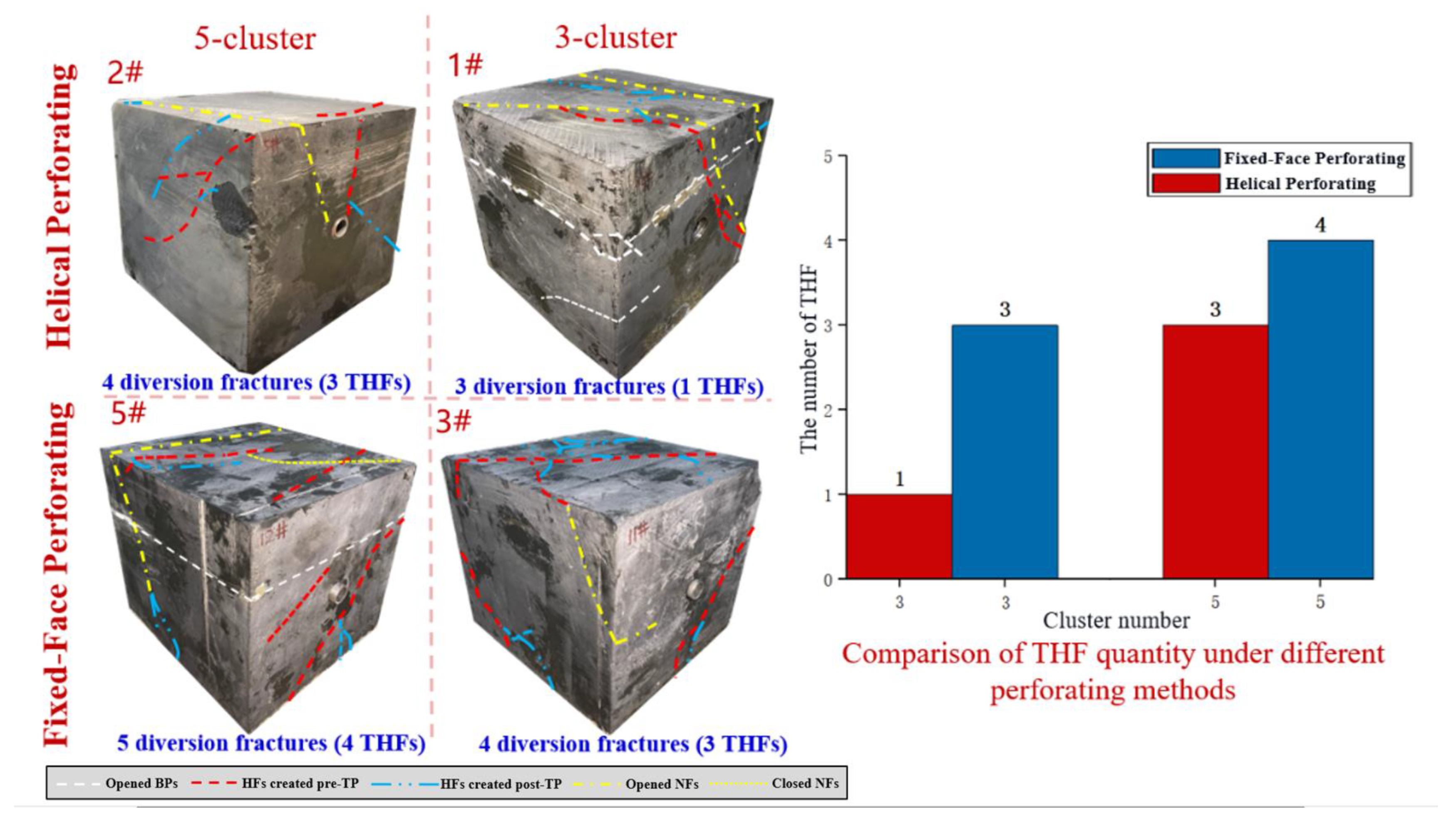
| Sample ID | Mineral Type (%) | |||
|---|---|---|---|---|
| Siliceous | Carbonate | Clay | Pyrite | |
| 1# | 52.0 | 9.1 | 35.9 | 4.8 |
| 2# | 51.2 | 6.7 | 34.1 | 7.6 |
| 3# | 51.4 | 11.9 | 29.3 | 7.2 |
| 4# | 52.7 | 10.3 | 31.9 | 3.9 |
| average | 51.8 | 9.5 | 32.8 | 5.9 |
| Core Orientation | Compressive Strength σc (MPa) | Young’s Modulus E (GPa) | Poisson’s Ratio |
|---|---|---|---|
| Parallel BPs | 389.4 | 49.1 | 0.277 |
| vertical BPs | 309.2 | 40.3 | 0.255 |
| Rock Sample ID | Number of Cluster | Perforating Method | Number of Perforation | Perforation Phase Angle (°) | Spacing between Perforations (mm) | Cluster Spacing (cm) | Perforation Diameter (mm) |
|---|---|---|---|---|---|---|---|
| 1# | 3 | helical perforating | 3 | 120 | 5 | 5 | 4 |
| 2# | 5 | 2.5 | |||||
| 3# | 7 | fixed-face perforating | 2 | 180 | — | 2 | |
| 4# | 3 | 5 | |||||
| 5# | 5 | 2.5 |
Disclaimer/Publisher’s Note: The statements, opinions and data contained in all publications are solely those of the individual author(s) and contributor(s) and not of MDPI and/or the editor(s). MDPI and/or the editor(s) disclaim responsibility for any injury to people or property resulting from any ideas, methods, instructions or products referred to in the content. |
© 2023 by the authors. Licensee MDPI, Basel, Switzerland. This article is an open access article distributed under the terms and conditions of the Creative Commons Attribution (CC BY) license (https://creativecommons.org/licenses/by/4.0/).
Share and Cite
Li, Y.; Shen, J.; Zou, L.; Zou, Y.; Ma, X.; Yang, C.; Wang, W. Multi-Fracture Growth Law for Temporary Plugging and Diversion Fracturing of Horizontal Well with Multiple Clusters in Shale Reservoir. Processes 2023, 11, 2251. https://doi.org/10.3390/pr11082251
Li Y, Shen J, Zou L, Zou Y, Ma X, Yang C, Wang W. Multi-Fracture Growth Law for Temporary Plugging and Diversion Fracturing of Horizontal Well with Multiple Clusters in Shale Reservoir. Processes. 2023; 11(8):2251. https://doi.org/10.3390/pr11082251
Chicago/Turabian StyleLi, Yanchao, Jianguo Shen, Longqing Zou, Yushi Zou, Xinfang Ma, Can Yang, and Weiwei Wang. 2023. "Multi-Fracture Growth Law for Temporary Plugging and Diversion Fracturing of Horizontal Well with Multiple Clusters in Shale Reservoir" Processes 11, no. 8: 2251. https://doi.org/10.3390/pr11082251




